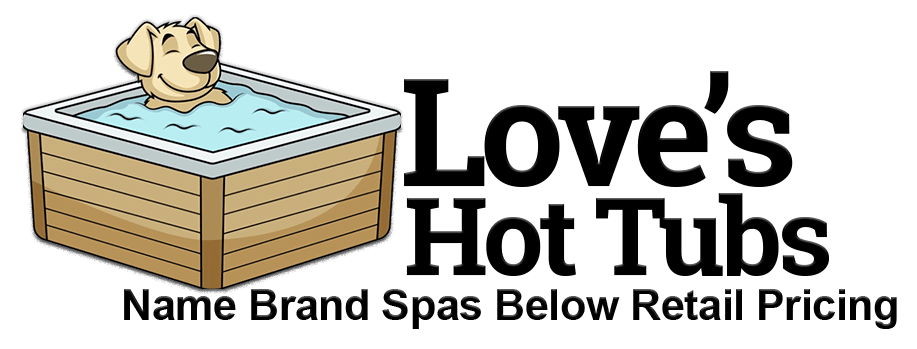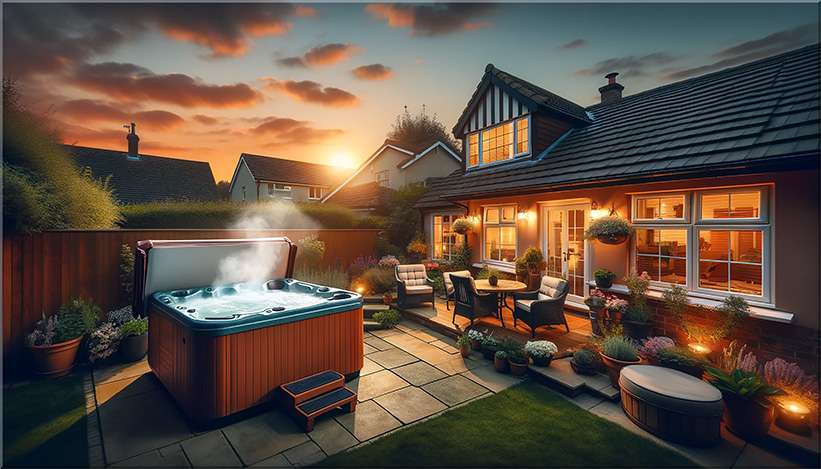Congratulations on your new hot tub! Owning a hot tub is one of those pleasures in life that combines relaxation, luxury, and wellness all in one. Whether it’s the allure of a warm soak under the stars or the therapeutic benefits of hydrotherapy, a hot tub can transform your home into a sanctuary of relaxation and enjoyment. This guide is designed specifically for new hot tub owners, offering essential tips and insights to navigate the exciting journey from purchase to your first dip. From installation to maintenance, we’ve got you covered. Welcome to the world of hot tubs, where every day promises a personal retreat.
If you have purchased your hot tub from Loves Hot Tubs, you know we offer free delivery and installation (not including electrical work). Whether or not you have purchased from us, this guide gives you an overall view of items to consider before your hot tub arrives and your first year of ownership.
The tips in the article will assist you in making sure your hot tub will last for many years to come.
Before Your Hot Tub Arrives
Site Selection: Beyond Aesthetics
Choosing the right location for your hot tub goes beyond just picking the most visually appealing spot in your yard. While aesthetics play a significant role, several practical aspects must be considered to ensure the optimal enjoyment and functionality of your hot tub:
- Privacy: Your hot tub should be a secluded oasis. Consider the line of sight from neighboring properties and think about landscaping, fencing, or privacy screens to create a more intimate setting.

- Accessibility: Think about the ease of access to your hot tub from your house, especially in colder climates. A path that is easy to navigate in all weather conditions will make your hot tub more inviting.
- View: Position your hot tub to take advantage of the best views your property offers, whether it’s a garden, a landscape feature, or the night sky.
Ground Preparation: Ensuring Stability
- Leveling: Use a level to check the ground where you plan to place your hot tub. Minor adjustments can be made by adding or removing soil or sand.
- Support: Consider the total weight of the hot tub, water, and occupants, which can easily exceed several thousand pounds. Ensure the site can handle this load without shifting or settling.
Structural Support: Platforms & Decks
For those considering placing their hot tub on a raised platform or deck, structural integrity becomes even more crucial:
- Engineering: A reinforced deck or a specially designed platform may be necessary to support the weight. Consulting with a structural engineer or a professional deck builder can provide peace of mind and ensure safety.
- Materials: Use materials suitable for weight and exposure to water, such as pressure-treated wood for decks or concrete pads for ground-level installations.
Professional Consultation: Safety & Compliance
- Local Regulations: Every area has its own set of building codes and regulations regarding hot tub installations. Professionals can help navigate these rules, ensuring your hot tub meets all legal requirements.
- Utility Placement: Understanding where to safely route electrical wiring and water lines is crucial. A professional can identify these utilities’ most efficient and safest paths, avoiding potential hazards.
Preparing your hot tub’s installation site is as important as selecting the hot tub itself. Taking the time to carefully plan and prepare the site enhances the enjoyment and functionality of your hot tub and ensures the installation’s safety and compliance. Whether it’s selecting the perfect spot, preparing the ground, reinforcing structural supports, or consulting with professionals, each step contributes to successfully integrating your hot tub into your home’s landscape. By addressing these considerations, you can look forward to countless relaxing and rejuvenating moments in your new hot tub..
Understanding Electrical Requirements
Please be aware: If you are new at electrical work, opting for professional electrician services ensures the safest and most reliable setup for your hot tub’s electrical requirements.
Before diving into the joy of hot tub ownership, it’s vital to grasp the electrical foundations essential for a safe and efficient setup. Hot tubs necessitate a stable electrical connection to power up heaters, pumps, and additional features, typically requiring a 220-240V, 50-60 amp circuit. This setup ensures that your hot tub operates smoothly, providing the ultimate relaxation experience without hitches.
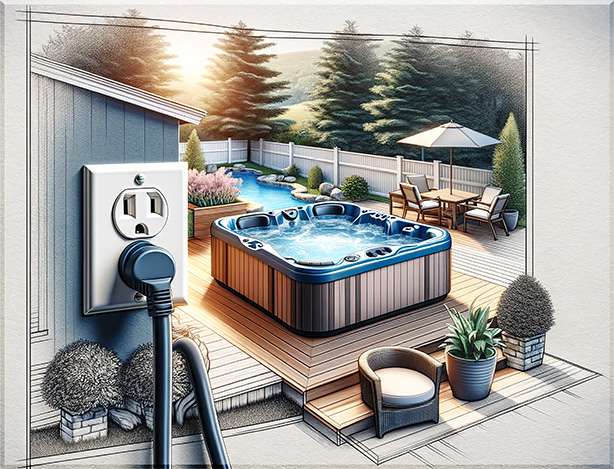
- Ground Fault Circuit Interrupter (GFCI) Breaker Installation
- Voltage and Amperage Requirements:
- Artesian Spa Models:
- Most operate on a 240V system.
- Single pump models can accommodate a 120V setup.
- Electrical Demand:
- 120V system requires a dedicated 15-20 amp circuit.
- 240V system requires a dedicated 40-60 amp circuit.
- Wiring Specifications
- Use flexible, waterproof cable suitable for outdoor conditions (UL-rated SJTW or STW recommended).
- For 240V Setup: Requires a 4-wire configuration (two hot wires, one neutral wire, and one ground wire).
- For 120V Setup: Requires a 3-wire configuration (one hot wire, one neutral wire, and one ground wire).Artesian Spas: Provides a GFCI 120V cord with purchase.
- Grounding:
- A crucial safety measure to prevent electrical risks.
- For 120V Models: Secure the ground wire to the green lug in the hot tub’s control box.
- For 240V Models: Secure the ground wire to the green lug in the GFCI box.
For more specific details tailored to your spa model, refer to the electrical requirements outlined in the Owner’s Manual and ensure your setup perfectly aligns with these guidelines for a worry-free hot tub experience.
What To Expect On Delivery Day
Installation day is exciting but requires some preparation. Ensure the delivery crew has clear access to the installation site, removing any obstacles that could hinder the process. Some companies offer a pre-delivery site inspection to anticipate any challenges. Be present during the installation to answer questions and understand the setup process. The installation team will handle the heavy lifting, positioning, and initial setup. Ask questions and take notes—this is your opportunity to learn from the experts.
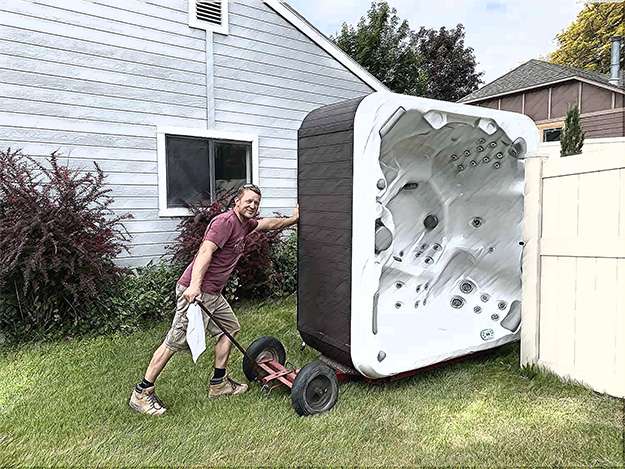
Preparing For A Smooth Installation Process
In addition to ensuring clear access, prepare a list of questions or concerns you might have about the installation process, maintenance, or hot tub features. This could include inquiries about your hot tub model’s electrical setup, water supply, or specific functions. Having these questions answered on installation day can save time and provide peace of mind as you move forward with your hot tub experience.
Initial Setup & Water Chemistry
Steps For The Initial Setup
Once your hot tub is installed, the first step is to fill it with water. Use a garden hose, and consider attaching a pre-filter to minimize impurities entering your spa. After filling, it’s time to start the initial heating process, which can take several hours depending on the model and external temperatures. During this time, familiarize yourself with the control panel and settings.
Basics Of Water Chemistry & Maintenance Tips for Beginners
Regular Maintenance
Daily, Weekly, Monthly & Yearly Maintenance Tasks
- Daily:
- Check the sanitizer level and adjust it as needed
- Remove any debris from the water surface with a skimmer
- Make sure the water circulation system is running properly
- Check the temperature and adjust as needed
- Weekly:
- Test and adjust pH and alkalinity levels.
- Shock the water with a high dose of sanitizer
- Clean the filter(s) and replace if necessary
- Check the water level and add more if needed
- Clean the hot tub cover and rinse it with water.
- Monthly:
- Drain and refill the hot tub with fresh water
- Clean the hot tub shell with a non-abrasive cleaner
- Clean the jets and other parts of the hot tub with a specialized cleaner
- Inspect the hot tub for any signs of damage or wear and tear
- Yearly:
- Have a professional inspect and service the hot tub’s electrical and plumbing components
- Inspect and replace damaged or worn parts, such as the cover or jets.
Energy Efficiency Tips
How To Minimize Operational Costs
Running a hot tub efficiently can significantly reduce its impact on your electricity bill. Use a high-quality insulated cover to minimize heat loss when the hot tub is not in use. Lower the thermostat during periods of non-use, or consider a hot tub with an eco-mode feature. Additionally, using a timer to control heating can align energy use with off-peak electricity rates.
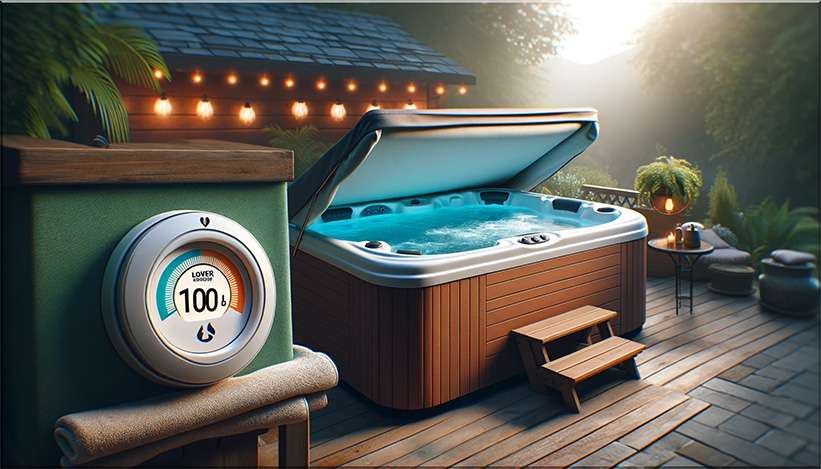
Recommendations For Covers, Settings, & Usage Patterns To Save Energy
The Critical Role Of A Hot Tub Cover In Energy Efficiency
A hot tub cover is not just an accessory; it’s an essential component for enhancing energy efficiency and achieving substantial cost savings. The principle behind its importance is simple: heat rises, and without a cover, a hot tub loses a significant amount of heat to its surroundings. This process, primarily through heat evaporation, accounts for the majority of energy loss in hot tubs. A well-insulated cover counters this by serving as a barrier that retains heat, maintaining the water’s temperature with far less energy requirement.
Quantifying Energy & Cost Savings
The impact of a cover on energy and cost savings varies based on climate, hot tub efficiency, and the cover’s quality. Here’s a breakdown of the potential savings:
- Without a Cover: Hot tubs without covers can lose 60-70% of their heat through evaporation, requiring the heater to operate more frequently and intensively. This is especially true in colder climates, where the absence of a cover leads to even greater energy loss.
- With a Cover: A high-quality insulated cover can curtail heat loss by up to 90-95%. This significant reduction means the heating system works less, translating into lower energy costs.
Approximate Cost Savings
For example, running a hot tub without a cover might cost between $50 to $70 monthly, depending on electricity rates and the tub’s efficiency. A robust, well-insulated cover can slash this expense to approximately $10 to $20 per month, offering annual savings in the ballpark of $480 to $600.
Enhancing Energy Savings Further
- Invest in Quality: Choose a hot tub cover with excellent insulation and a snug fit to maximize heat retention.
- Temperature Management: Adjust the hot tub’s temperature settings based on your usage patterns. There’s no necessity to maintain your ideal soaking temperature continuously; lowering it during periods of non-use can lead to more savings.
- Strategic Usage: Plan your hot tub sessions to minimize the need for heating from a cold start, which uses more energy. Keeping the water at a moderate temperature that only requires slight adjustments before use can be more energy-efficient.
By following these recommendations and understanding the role and benefits of a hot tub cover, you can enjoy your hot tub’s luxurious warmth and therapeutic benefits more sustainably and affordably. This approach not only enhances your hot tub experience but also contributes to a more energy-efficient and cost-effective operation.
Enjoying Your Hot Tub
Safe Usage Guidelines
Ensuring safety while enjoying your hot tub is paramount. Always keep hydrated, especially during longer sessions, and avoid alcohol consumption to prevent dehydration and overheating. It’s advisable to limit temperatures between 100°F and 104°F (37°C to 40°C) for 15-30 minutes at a time, especially at higher temperatures, to avoid health risks.
Suppose the water is hotter than the recommended range. In that case, reducing your soaking time is advisable to avoid overheating or dehydration. Conversely, you can extend your soak if the water is colder than this range. This will compensate for the lower temperature.
Kids
For young children ages 5 and up, use caution. The temperature should be Between 95 and 98 °F no more than 15 minutes. They also recommend children do not fully immerse themselves in hot water. For children under the age of 5, it is highly advised that they should not use the hot tub.
Children’s bodies are still developing and may have a lower tolerance for hot water temperatures than adults. Therefore, monitoring their comfort level, limiting their soaking time, and ensuring they stay hydrated during the hot tub session is essential
For families with children, enforce supervised use and establish clear rules about behavior in and around the hot tub to prevent accidents.
Consult With A Healthcare
Ultimately, deciding when a child can start using a hot tub varies. It should be based on their individual development, maturity, and overall health. Therefore, consulting with a healthcare professional or pediatrician for specific guidance tailored to your child’s needs is strongly recommended. They can provide the most accurate and appropriate recommendations based on the child’s age, health status, and specific considerations.
Meeting Safety Standards
Adding Safety Features
Beyond meeting safety standards, consider enhancing your hot tub with additional safety features. A cover is vital for keeping the water clean, maintaining a consistent temperature, and preventing accidents by stopping small children or pets from accidentally falling in when the hot tub is not in use. Handrails offer stability and support when entering or exiting the hot tub, benefiting older adults or individuals with mobility issues.
Supervision
Always supervise children and pets around the hot tub. Children should never be left unattended near a hot tub, even with the cover securely in place. Ensure pets do not jump or fall into the hot tub, always keeping their safety in mind.
By prioritizing safety, including adhering to safety standards, incorporating additional safety features, following proper usage and maintenance protocols, and supervising children and pets, you can enjoy the benefits of your hot tub while minimizing potential risks. For further insights on the ideal duration for hot tub use, refer to our article, “Soaking In a Hot Tub: How Long Is Just Right?”
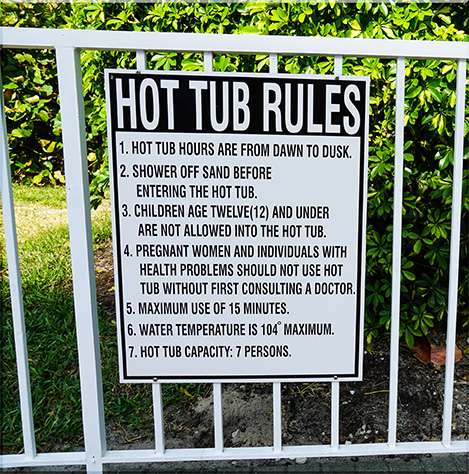
Ideas for Making the Most Out of Your Hot Tub Experience
Owning a hot tub is an invitation to enhance your lifestyle in numerous ways. Beyond the basic soak, there are myriad opportunities to elevate your hot tub experience, turning it into a hub of relaxation, health, and social interaction. Here are some ideas to help you make the most of your hot tub:
Enhance the Ambiance
Creating the right atmosphere can significantly enhance your hot tub experience:
- Outdoor Lighting: Strategically placed lighting can transform your hot tub area into a magical space. Consider soft, waterproof LED lights for a gentle glow or solar-powered lanterns for an eco-friendly option. Underwater lights can also add a mesmerizing effect.
- Landscaping: Adding greenery around your hot tub enhances privacy and integrates your spa into the natural surroundings. Consider plants that emit pleasant fragrances or those that can add a touch of color throughout the seasons.
- Gazebo or Pergola: Installing a gazebo or pergola provides shade, adds privacy, and creates a defined space for your hot tub. It can also be a mounting point for lights, speakers, or even a small outdoor fan.

Upgrade with Accessories
Select accessories can significantly boost the functionality and enjoyment of your hot tub:
- Waterproof Speakers: A quality set of waterproof speakers can allow you to enjoy your favorite tunes without worrying about water damage. Music can set the mood for relaxation or a social gathering.
- Aromatherapy Products: Specially designed for hot tub use, these products can add a sensory layer to your soak. Scents like lavender for relaxation or eucalyptus for invigoration can be chosen based on your mood or desired effect.
- Drink Holders and Snack Trays: Invest in hot tub-safe drink holders and snack trays to keep your beverages and light snacks within reach. These accessories are perfect for those long, leisurely soaks or hosting friends and family.
Leverage Health Benefits
A hot tub can be a powerful tool in your wellness routine:
- Hydrotherapy Sessions: Utilize the therapeutic power of water jets to massage and soothe sore muscles. Targeted jet streams can help relieve tension in specific areas, enhancing muscle recovery and flexibility.
- Stress Reduction: The combination of warm water, buoyancy, and massage can significantly reduce stress levels. Practice deep breathing or meditation in your hot tub for a more profound relaxation experience.
- Improved Sleep: A hot tub session before bedtime can improve sleep quality. The drop in body temperature after getting out of the hot tub can signal your body that it’s time to sleep, helping you to fall asleep faster and enjoy a deeper sleep.

Social & Family Time
- Family Gatherings: A hot tub can be the centerpiece for family time, offering a relaxed environment for conversation and bonding without the distractions of technolog
- Entertaining Friends: Hosting hot tub parties or casual get-togethers can be a unique way to entertain. Ensure you have ample seating, towels, and perhaps a nearby fire pit for guests to enjoy throughout the evening.
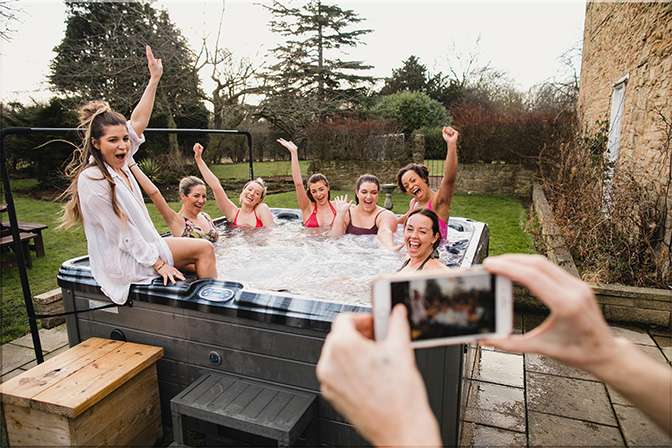
By incorporating these ideas into your hot tub experience, you can transform your spa into a versatile oasis that caters to relaxation, health, and social needs. Remember, the key to maximizing your hot tub experience is personalizing the space and activities to reflect your preferences and lifestyle.
Final Thoughts
Deeper Dive
On A Side Note:
Mastering Hot Tub Terminology: A Must for Every Owner
Becoming a hot tub owner introduces you to a new world of relaxation and wellness and a specialized vocabulary that can help you better understand and care for your investment. From technical terms related to water chemistry and maintenance to features and accessories that enhance your experience, knowing the language of hot tubs is invaluable.
Artesian Spas offers an extensive glossary for those eager to deepen their understanding and fluency in hot tub terminology. Their “100 Hot Tub Terms You Need to Know As A Hot Tub Owner,” available on their blog, is a comprehensive resource that covers essential jargon. This glossary is an excellent tool for demystifying terms related to:
- Water Treatment: Learn about alkalinity, pH balance, sanitizers, and more to keep your spa water clear and safe.
- Equipment: Get to know the components of your hot tub, from pumps and heaters to filters and jets.
- Safety Features: Understand the importance of GFCI protection, covers, and other safety aspects of hot tub use.
- Hot Tub Maintenance: Familiarize yourself with the routine tasks and products that will keep your hot tub running smoothly.
